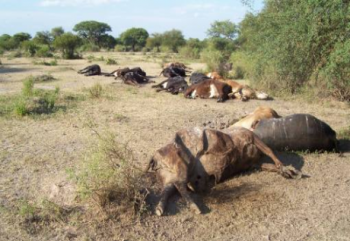By Ana Belluscio*
 Dead cattle litter a field at Villa Minetti in the Argentine province of Santa Fe. Photo: Marcelo Banchi, Argentina Agrarian FederationBUENOS AIRES, Argentina (AlertNet) – For almost two months, an intense drought has been damaging crops in Argentina, especially corn and soy, threatening the economic and food security of a country where agriculture and livestock account for approximately 10 percent of GDP.
Dead cattle litter a field at Villa Minetti in the Argentine province of Santa Fe. Photo: Marcelo Banchi, Argentina Agrarian FederationBUENOS AIRES, Argentina (AlertNet) – For almost two months, an intense drought has been damaging crops in Argentina, especially corn and soy, threatening the economic and food security of a country where agriculture and livestock account for approximately 10 percent of GDP.
German Cuadrada rents 220 hectares (540 acres) of land in Pozo del Molle, Cordoba province, where he grows maize and soybeans. Since December he has lost his entire maize crop and part of his soybeans.
“If we don’t receive a 100-150 mm (4-6 inches) rainfall within the next days we are not going to make it,” he said.
According to specialists, the drought is the consequence of a recent La Nina episode – the cooling of the surface temperature of the equatorial Pacific Ocean that influences wind and rainfall.
In Argentina, La Nina causes rainfall below normal levels, coupled with higher than average temperatures, especially during December and January, said Pablo Mercuri, director of the Institute of Weather and Water of the National Agricultural Technology Institute (INTA).
Scientists are working to determine whether there is a correlation between the higher incidence of La Nina events in recent decades and climate change.
WORSENING DROUGHT
Historical records show that La Nina-induced droughts formerly were not to be as long or severe as today’s, said Lucas di Pietro Paolo, climate change adaptation coordinator at the government’s Secretariat of Environment and Sustainable Development.
Although investigations are incomplete, Mercuri and his team have noted an increasing number of extreme climate events occurring in the country along with high climatic variability compared to recent decades. Both of these parameters are associated with climate change, the scientists say.
“Perhaps there is no rain for 30 or 40 days and suddenly 140 mm of rain in one afternoon” in a particular area, Mercuri said. Prolonged drought, intense frost and floods are also more frequent.
The current drought is affecting the centre and northeast of the country, areas traditionally associated with agriculture and cattle. Agrarian associations report up to 60 percent losses in maize crops due to the drought, and say that up to 30 percent of soybean production may be compromised if rainfall does not arrive soon.
The current drought “created a water stress situation very rapidly, affecting crops undergoing their maximum demand for water,” explained Mercuri.
December’s rainfall was at a historical low, according to Mercuri, and this combined with high temperatures led to a significant evaporation of water from the soil and from crops.
In Cordoba, Cuadrada says that he may go bankrupt without economic support from the government. Like most small-scale farmers, he relies on the revenue from seasonal crops to pay the rent on his land and to buy seeds for his next crop.
GOVERNMENT SUPPORT PAYMENTS
To alleviate the situation, the national government has designated 500 million pesos ($115 million) to help small producers. According to economic consultants Finsoport, the drought has so far caused an 11 percent reduction in grain crops this season, and over $1 billion of losses in crops and taxes.
But di Pietro Paolo believes that apart from palliatives for the current situation, long-term solutions must be found to the possible effects of climate change, which he says are likely to increase.
“We have to generate tools to seriously evaluate what is happening” to the climate, he said.
In December 2011 the national government presented the second phase of its National Strategy in Climate Change. The project involves aims to create a unified system, database and resource centre to coordinate the efforts of government ministries and agencies addressing problems related to climate change.
Projects in recent years have mostly been related to sustainable soil management and combating desertification, water shortages and climate variability. In addition, laws were passed to protect native forest and glaciers in 2007 and 2010, respectively.
Argentina recently applied to the Kyoto Protocol’s Adaptation Fund to implement a $4 million project to manage the water and weather impact of climate change in agricultural production in the most affected areas.
Di Pietro Paolo hopes this new project will “start generating good practices and experiences in management of the hydro-meteorological impact on livestock and agriculture,” in order to minimize the effects of possible new droughts or climate events.
* Ana Belluscio is an Argentine journalist who covers environmental and science issues.
Taken from http://www.trust.org/alertnet/

